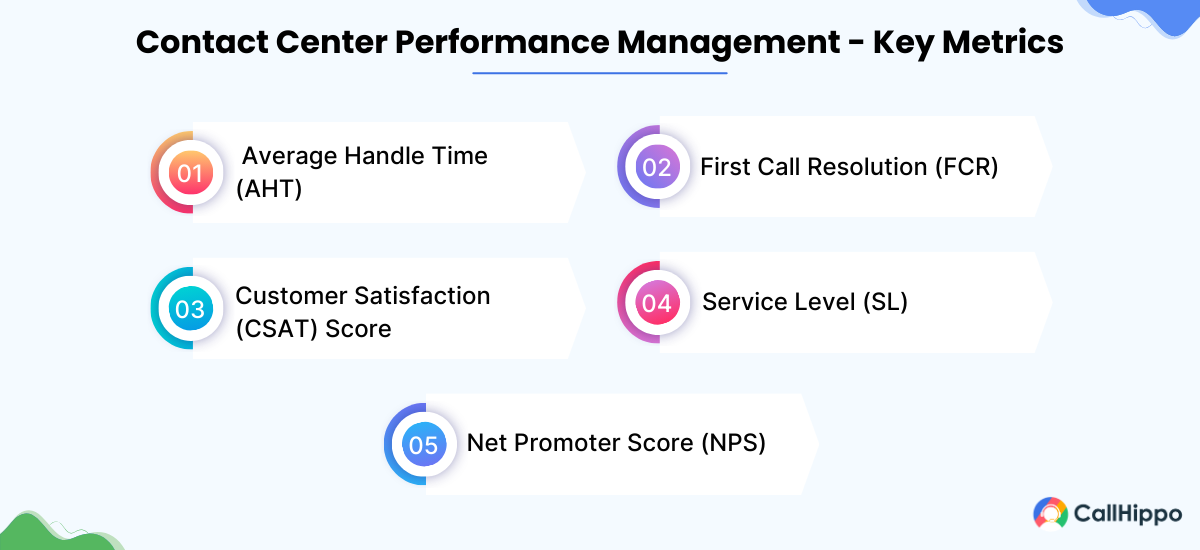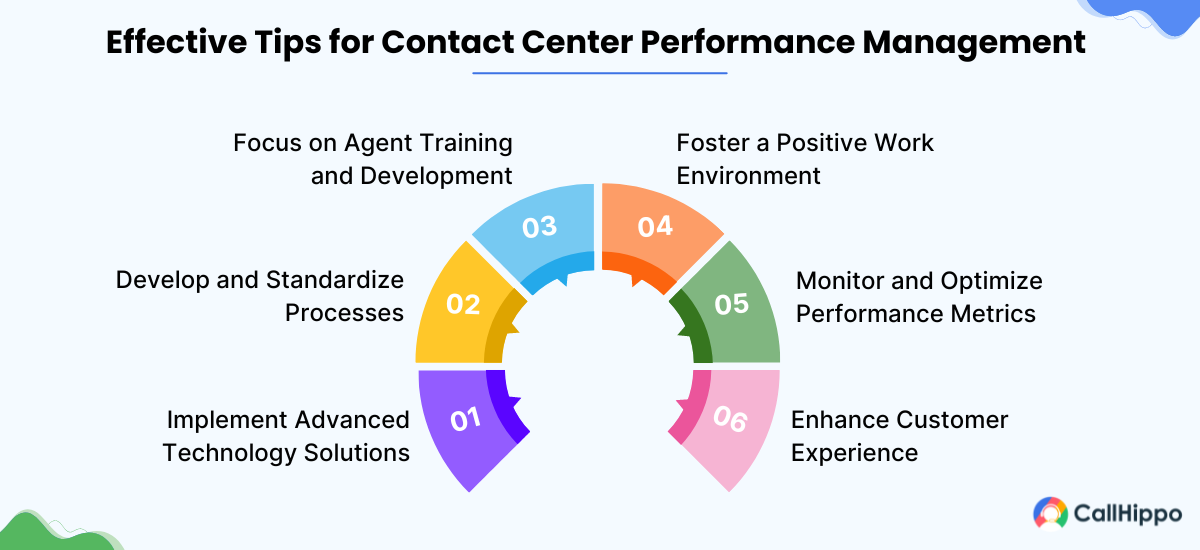A contact center serves as a crucial point of interaction between a company and its customers. It’s a hub where inquiries are addressed, issues are resolved, and relationships are built. Therefore, managing the performance of a contact center is paramount to ensuring customer satisfaction, operational efficiency, and overall business success.
This blog delves into the intricacies of contact center performance management, exploring its definition, significance, and the key metrics involved.
Understanding Contact Center Performance Management
Contact Center Performance Management (CCPM) encompasses a broad range of strategies, tools, and practices designed to monitor, evaluate, and improve the efficiency and effectiveness of a contact center.
The goal is to deliver exceptional customer service while optimizing resources and minimizing costs. Effective performance management ensures that the contact center aligns with the company’s broader objectives, meets customer expectations, and continuously improves its operations.
Importance of CCPM
- Customer Satisfaction: A well-managed contact center enhances customer experiences, leading to higher satisfaction rates and loyalty.
- Operational Efficiency: By monitoring and optimizing call center processes, contact centers can handle more calls with fewer resources, reducing operational costs.
- Employee Performance: Regular performance evaluations help in identifying training needs, recognizing top performers, and maintaining high morale.
- Strategic Insights: Performance data provides valuable insights that can guide decision-making and strategic planning.
Prioritize implementing advanced analytics and real-time monitoring tools to gain actionable insights. Focus on continuous agent training and development to maintain high service quality and foster a positive work environment to enhance agent satisfaction and retention.
Key Metrics for Contact Center Performance Management
The effectiveness of a contact center is measured using a variety of metrics. These metrics provide insights into different aspects of performance, from operational efficiency to customer satisfaction. The effectiveness of a contact center is measured using a variety of metrics. These metrics provide insights into different aspects of performance, from operational efficiency to customer satisfaction.

1. Average Handle Time (AHT)
The average time taken to handle a call, including talk time, hold time, and after-call work.
Formula:

AHT helps in understanding the efficiency of call handling processes. Lower Average Handling Time indicates efficient processes but should not compromise the quality of service.
2. First Call Resolution (FCR)
The percentage of calls resolved on the first contact without the need for follow-up.
Formula:

High first call resolution rates are indicative of effective problem-solving and customer satisfaction. It reduces repeat calls and enhances operational efficiency.
3. Customer Satisfaction (CSAT) Score
A measure of customer satisfaction with the service received is usually obtained through post-call surveys.
Formula:

CSAT scores directly reflect the quality of customer service and are crucial for assessing customer perceptions and loyalty.
4. Service Level (SL)
The percentage of calls answered within a specified time frame, often 20 or 30 seconds.
Formula:

SL measures the accessibility and responsiveness of the contact center. Meeting or exceeding SL targets ensures customers are not kept waiting long, improving their experience.
5. Net Promoter Score (NPS)
A measure of customer loyalty and likelihood to recommend the company to others.
Formula:

NPS is a key indicator of overall customer satisfaction and future business growth. It helps identify promoters and detractors among the customer base.
Tips for Effective Contact Center Performance Management
Managing the performance of a contact center involves implementing tips and tactics that optimize operational efficiency, enhance customer satisfaction, and ensure the well-being of agents. Below are detailed tips for effective performance management in contact centers.

1. Implement Advanced Technology Solutions
Leveraging advanced technology solutions can significantly enhance the efficiency and effectiveness of contact center operations. These tools help streamline processes, improve communication, and provide valuable data for performance management.
A. Call Routing and IVR Systems
Advanced call routing and Interactive Voice Response (IVR) systems ensure that calls are directed to the right agents with the appropriate skills to handle specific inquiries. This reduces call transfer rates and improves First Call Resolution (FCR).
B. Workforce Management Software
Workforce management (WFM) software helps in forecasting call volumes, scheduling agents effectively, and managing real-time adherence. This ensures that the contact center is adequately staffed to handle varying call volumes.
C. Analytics and Reporting Tools
Analytics and contact center reporting tools are essential for monitoring key performance metrics, identifying trends, and generating actionable insights. Real-time dashboards and custom reports enable managers to make informed decisions quickly.
2. Develop and Standardize Processes
Standardized processes ensure consistency and quality across all customer interactions in the contact center. Clear, well-documented procedures help agents understand their roles and responsibilities, leading to improved performance and customer satisfaction.
A. Call Handling Procedures
Establish standardized procedures for call handling, including greeting scripts, issue resolution protocols, and call wrap-up processes. Consistent processes ensure high-quality interactions and efficient problem-solving.
B. Adopt Quality Assurance (QA) Programs
Implement robust QA programs to regularly evaluate and score agent interactions based on predefined criteria. QA reviews help identify areas for improvement and ensure adherence to service standards.
C. Leverage Knowledge Management Systems
Develop and maintain a centralized knowledge management system that contact center agents can easily access for information on products, services, and troubleshooting guides. This reduces call handling time and enhances FCR rates.
3. Focus on Agent Training and Development
Investing in agent training and development is crucial for maintaining a high level of service and performance. Continuous learning opportunities help agents stay updated on best practices and improve their skills.
A. Implement comprehensive Onboarding Programs
Provide new agents with thorough onboarding programs that cover company policies, contact center procedures, and product knowledge. Effective onboarding sets the foundation for agent success.
B. Ongoing Training and Skill Development
Offer continuous training programs to enhance agent skills, including communication, problem-solving, and technical knowledge. Regular training keeps agents updated on new products, services, and industry best practices.
C. Coaching and Feedback
Implement regular coaching sessions where supervisors provide constructive feedback based on performance evaluations. One-on-one coaching helps agents understand their strengths and areas for improvement.
D. Cross-Training
Encourage cross-training to equip agents with the ability to handle multiple types of inquiries. This increases flexibility in staffing and improves overall contact center efficiency.
Optimize Contact Center Performance
Enhance efficiency and customer satisfaction with CallHippo's advanced tools.
4. Foster a Positive Work Environment
A positive work environment is essential for agent satisfaction and retention. Happy and motivated agents are more likely to perform well and provide excellent customer service.
A. Employee Recognition Programs
Recognize and reward agents for their performance through employee recognition programs. Acknowledging achievements boosts morale and motivates agents to maintain high performance levels.
B. Work-Life Balance Initiatives
Promote a healthy work-life balance by offering flexible scheduling options and adequate break times. A supportive work environment reduces burnout and turnover rates.
C. Team Building Activities
Organize team-building activities to strengthen relationships among agents and foster a sense of camaraderie. A cohesive team environment enhances collaboration and overall performance.
5. Monitor and Optimize Performance Metrics
Regularly monitoring performance metrics is critical for understanding how well the contact center is performing. Analyzing these metrics helps identify areas for improvement and track progress over time.
A. Regular Performance Reviews
Conduct regular performance reviews to assess agent performance against key performance indicators such as Average Handle Time (AHT), Customer Satisfaction (CSAT) scores, and FCR rates. Reviews help in setting goals and identifying improvement opportunities.
B. Benchmarking
Compare performance metrics against industry standards and best practices. Benchmarking helps identify areas where the contact center excels and areas needing improvement.
C. Continuous Improvement Programs
Establish continuous improvement programs that involve setting performance targets, implementing changes, and monitoring outcomes. Encourage a culture of ongoing improvement and innovation.
6. Enhance Customer Experience
Enhancing the customer experience is at the heart of effective contact center performance management. By focusing on customer needs and expectations, contact centers can build strong relationships and drive loyalty.
A. Customer Feedback Mechanisms
Implement customer feedback mechanisms such as post-call surveys and feedback forms. Analyzing customer feedback provides insights into service quality and areas for enhancement.
B. Personalization
Use customer data to personalize interactions and offer tailored solutions. Personalized service increases customer satisfaction and loyalty.
C. Omnichannel Support
Provide omnichannel support by integrating various communication channels such as phone, email, chat, and social media. Seamless channel integration ensures a consistent customer experience across all touchpoints.
Conclusion
Ultimately, the success of a contact center hinges on its ability to deliver exceptional customer service while maintaining operational excellence. Investing in robust performance management practices is essential for achieving long-term success, sustaining competitive advantage, and driving business growth.
By focusing on these key areas, contact centers can build strong customer relationships, improve agent performance, and ensure a high level of service quality, positioning themselves as critical assets to their organizations.
FAQs
1. What is contact center performance management?
Contact center performance management encompasses strategies, tools, and practices designed to monitor, evaluate, and enhance the efficiency and effectiveness of a contact center, ensuring alignment with business goals and customer satisfaction.
2. How can performance management software benefit my contact center?
Performance management software, or contact center performance management software, benefits your contact center by providing advanced call routing, real-time analytics, workforce planning, and CRM integration, leading to improved operational efficiency, better resource allocation, and enhanced customer service.
3. What are some key metrics to track in contact center performance management?
Key metrics to track include Average Handle Time (AHT), First Call Resolution (FCR), Customer Satisfaction (CSAT) scores, Net Promoter Score (NPS), Service Level (SL), Occupancy Rate, Abandonment Rate, Quality Scores, Cost per Call (CPC), and Agent Turnover Rate.
4. How can I improve performance management in my contact center?
To improve performance management, implement advanced technology solutions, standardize processes, provide continuous training and development for agents, foster a positive work environment, monitor and optimize key performance metrics, enhance customer experience, and utilize data-driven decision-making.

Subscribe to our newsletter & never miss our latest news and promotions.









